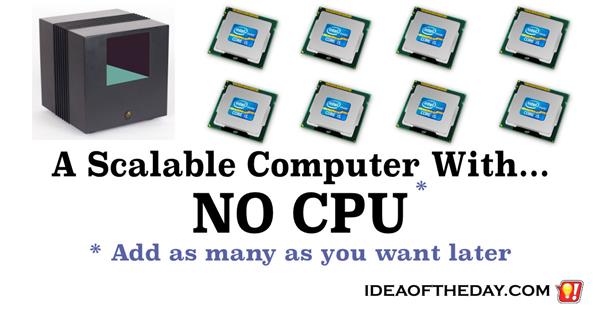A Computer With NO CPU. Just Add As Many As You Need Later.

By
Staten Island, NY Posted: 1/25/2015 1:00:00 AM
Even though the CPU is the heart of every computer today, I think there's another way. A computer with NO CPU. Modular. Scalable. Better.
In the early days of computing, it was common for computers to have the ability to upgrade them as new technology came along.
Over the years, the concept of upgrading a computer faded away. I think with today's technology, we can not only build computers that are upgradable, but completely modular, making it unnecessary to upgrade an entire computer.
In fact, by leaving the CPU out of the computer itself, it opens up an entirely new design which can allow you to add as many CPUs you want down the road. Here's how it would work.
To understand my idea, think of your existing computer. It has a screen, video card, memory, hard drives, and ports to connect things like keyboards, printers, and other gadgets.
If you noticed, I left out the most important part, the CPU, which serves as the "Brain" of your computer. Assuming you built a box with all those parts, and left out the CPU, you wouldn't get much done.
At best, a computer with just the video card and screen would give you a blank screen. That's a great start.
There you have it. If you built a "Box" that has only the fundamental components needed to generate a blank screen you would have the foundation for an entirely new class of computer, a truly modular computer.
While there wouldn't be a CPU, I should point out that there would likely be a simple processor on the motherboard, but it's sole purpose would be to interact with the ports, and act as a traffic cop. That's it. This processor should serve no other purpose. That's where things get interesting.
Next, you would insert one or more CPU boards. Each could either have it's own memory, or share some from the main box. It's not important to the design, but it would work either way.
The role of each CPU board would be to independently boot it's own operating system, and launch it's own programs. Instead of using a conventional video board, it would send display information to the "Box" itself, allowing user to select what portion of the screen(s) that particular CPU will occupy... it any. They would make it take up the whole screen, a window, or possibly interact with a separate screen.
Among other things, this means is that you would theoretically be able to swap out or add any components as newer versions come along, while keeping others. It also means this design has no pre-set limits. Each of the CPU boards need not interact with any of the other CPU boards, although that would be possible, if they eventually need to work together.
As a truly modular computer, you would use a control panel on the main display to add ports, video cards, and other devices as needed.
This scenario may sound familiar to anyone who has managed a room full of servers. Generally, servers don't have screens, so the Administrator uses a central keyboard and screen to control all of them. If we scaled this down to the desktop level, somebody sitting at a desk could run dozens of CPU draining programs at the same time, without any of the programs slowing down. This would be possible if the "Box" on their desk had dozens of CPUs (or CPU cores), that shared a common screen, keyboard and mouse.
Unlike remotely controlling individual servers, the individual CPUs could share all or part of the display at the same time.
 Joe Crescenzi, Founder
Joe Crescenzi, Founder
Related Media:

(Reply N/A) (Edit Topic N/A)
(Like Topic N/A) [0 ] 6508 Views
Related Posts
Computing(108)Inventions(65)Virtual PCs(2)
Top 25 Posts
* Note: The ideas on "Idea of the Day" were posted without any formal research into existing inventions.
In some cases, patents may already exist for these ideas, in other cases, there may not be any existing patents and you are free to develop and explore the viability of developing and patenting the ideas.
The authors make no claim that any of the ideas are safe, practical, or suitable for any particular purpose. You are responsible for the results of trying, developing, patenting or using any of the ideas on this site.
For some people, our ideas are just an interesting read, but our goal is to encourage you to take action. If you see an idea that you like, do something with it... Take action.
- Joe
 on...
on...